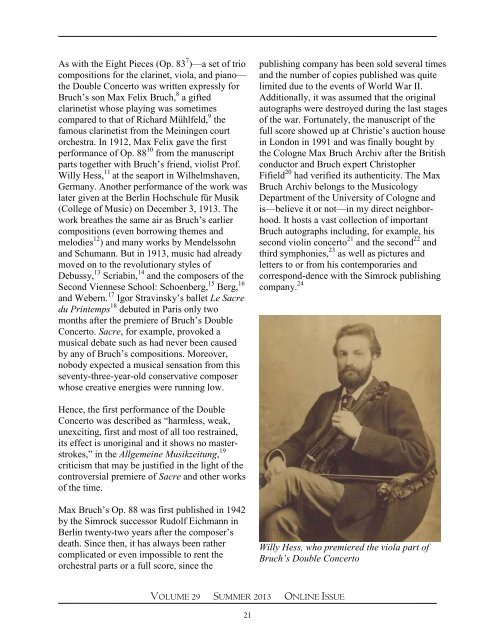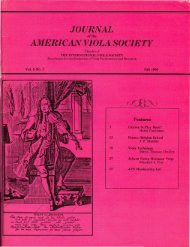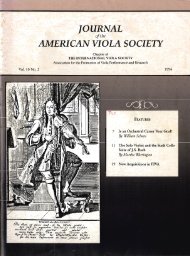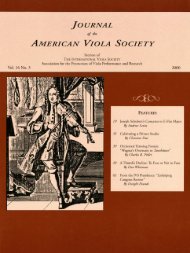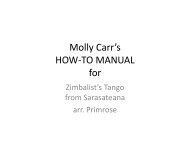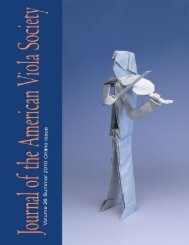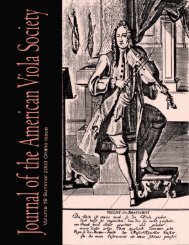Summer 2013 - The American Viola Society
Summer 2013 - The American Viola Society
Summer 2013 - The American Viola Society
Create successful ePaper yourself
Turn your PDF publications into a flip-book with our unique Google optimized e-Paper software.
As with the Eight Pieces (Op. 83 7 )—a set of trio<br />
compositions for the clarinet, viola, and piano—<br />
the Double Concerto was written expressly for<br />
Bruch’s son Max Felix Bruch, 8 a gifted<br />
clarinetist whose playing was sometimes<br />
compared to that of Richard Mühlfeld, 9 the<br />
famous clarinetist from the Meiningen court<br />
orchestra. In 1912, Max Felix gave the first<br />
performance of Op. 88 10 from the manuscript<br />
parts together with Bruch’s friend, violist Prof.<br />
Willy Hess, 11 at the seaport in Wilhelmshaven,<br />
Germany. Another performance of the work was<br />
later given at the Berlin Hochschule für Musik<br />
(College of Music) on December 3, 1913. <strong>The</strong><br />
work breathes the same air as Bruch’s earlier<br />
compositions (even borrowing themes and<br />
melodies 12 ) and many works by Mendelssohn<br />
and Schumann. But in 1913, music had already<br />
moved on to the revolutionary styles of<br />
Debussy, 13 Scriabin, 14 and the composers of the<br />
Second Viennese School: Schoenberg, 15 Berg, 16<br />
and Webern. 17 Igor Stravinsky’s ballet Le Sacre<br />
du Printemps 18 debuted in Paris only two<br />
months after the premiere of Bruch’s Double<br />
Concerto. Sacre, for example, provoked a<br />
musical debate such as had never been caused<br />
by any of Bruch’s compositions. Moreover,<br />
nobody expected a musical sensation from this<br />
seventy-three-year-old conservative composer<br />
whose creative energies were running low.<br />
publishing company has been sold several times<br />
and the number of copies published was quite<br />
limited due to the events of World War II.<br />
Additionally, it was assumed that the original<br />
autographs were destroyed during the last stages<br />
of the war. Fortunately, the manuscript of the<br />
full score showed up at Christie’s auction house<br />
in London in 1991 and was finally bought by<br />
the Cologne Max Bruch Archiv after the British<br />
conductor and Bruch expert Christopher<br />
Fifield 20 had verified its authenticity. <strong>The</strong> Max<br />
Bruch Archiv belongs to the Musicology<br />
Department of the University of Cologne and<br />
is—believe it or not—in my direct neighborhood.<br />
It hosts a vast collection of important<br />
Bruch autographs including, for example, his<br />
second violin concerto 21 and the second 22 and<br />
third symphonies, 23 as well as pictures and<br />
letters to or from his contemporaries and<br />
correspond-dence with the Simrock publishing<br />
company. 24<br />
Hence, the first performance of the Double<br />
Concerto was described as “harmless, weak,<br />
unexciting, first and most of all too restrained,<br />
its effect is unoriginal and it shows no masterstrokes,”<br />
in the Allgemeine Musikzeitung, 19<br />
criticism that may be justified in the light of the<br />
controversial premiere of Sacre and other works<br />
of the time.<br />
Max Bruch’s Op. 88 was first published in 1942<br />
by the Simrock successor Rudolf Eichmann in<br />
Berlin twenty-two years after the composer’s<br />
death. Since then, it has always been rather<br />
complicated or even impossible to rent the<br />
orchestral parts or a full score, since the<br />
Willy Hess, who premiered the viola part of<br />
Bruch’s Double Concerto<br />
VOLUME 29 SUMMER <strong>2013</strong> ONLINE ISSUE<br />
21


